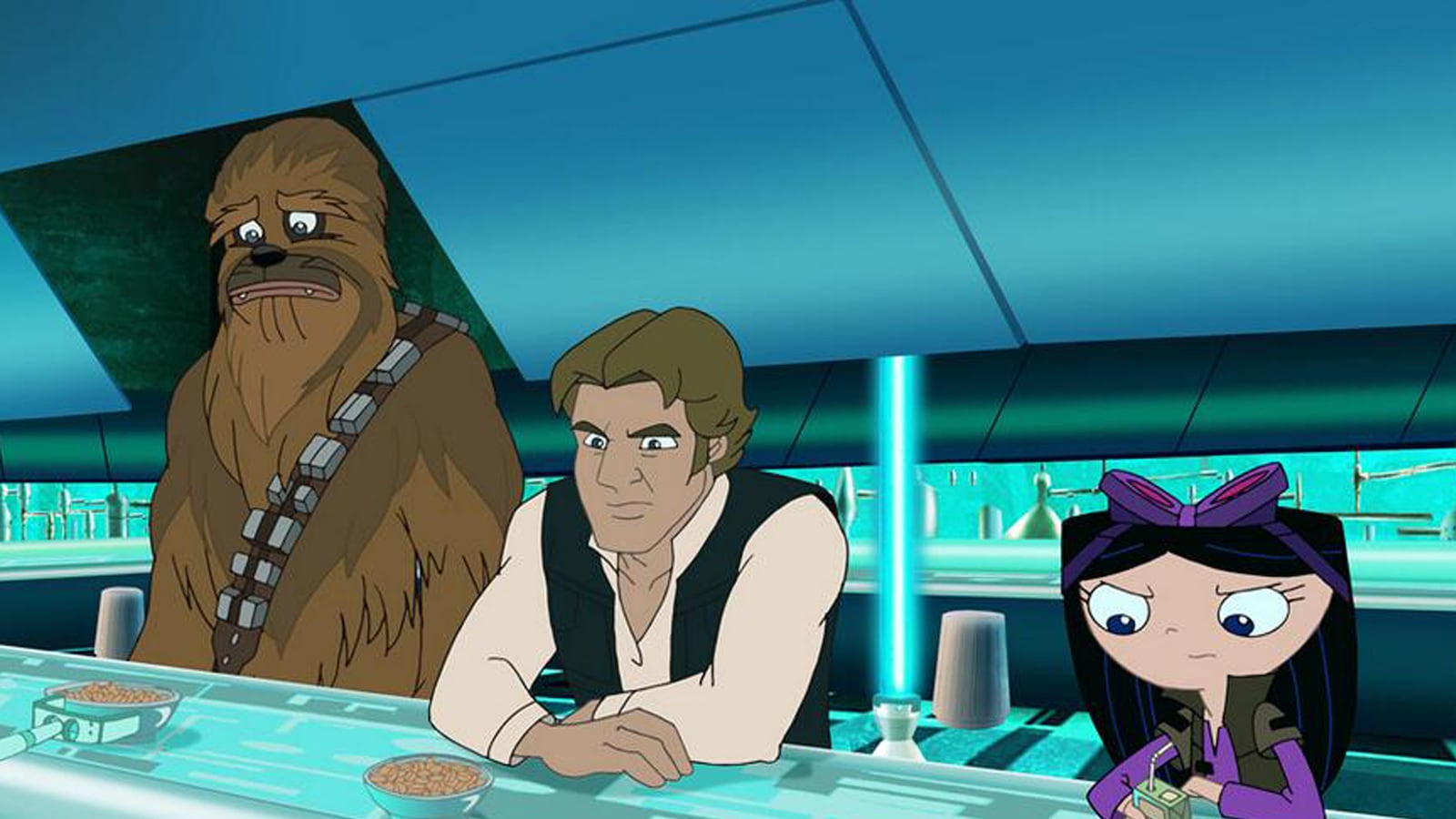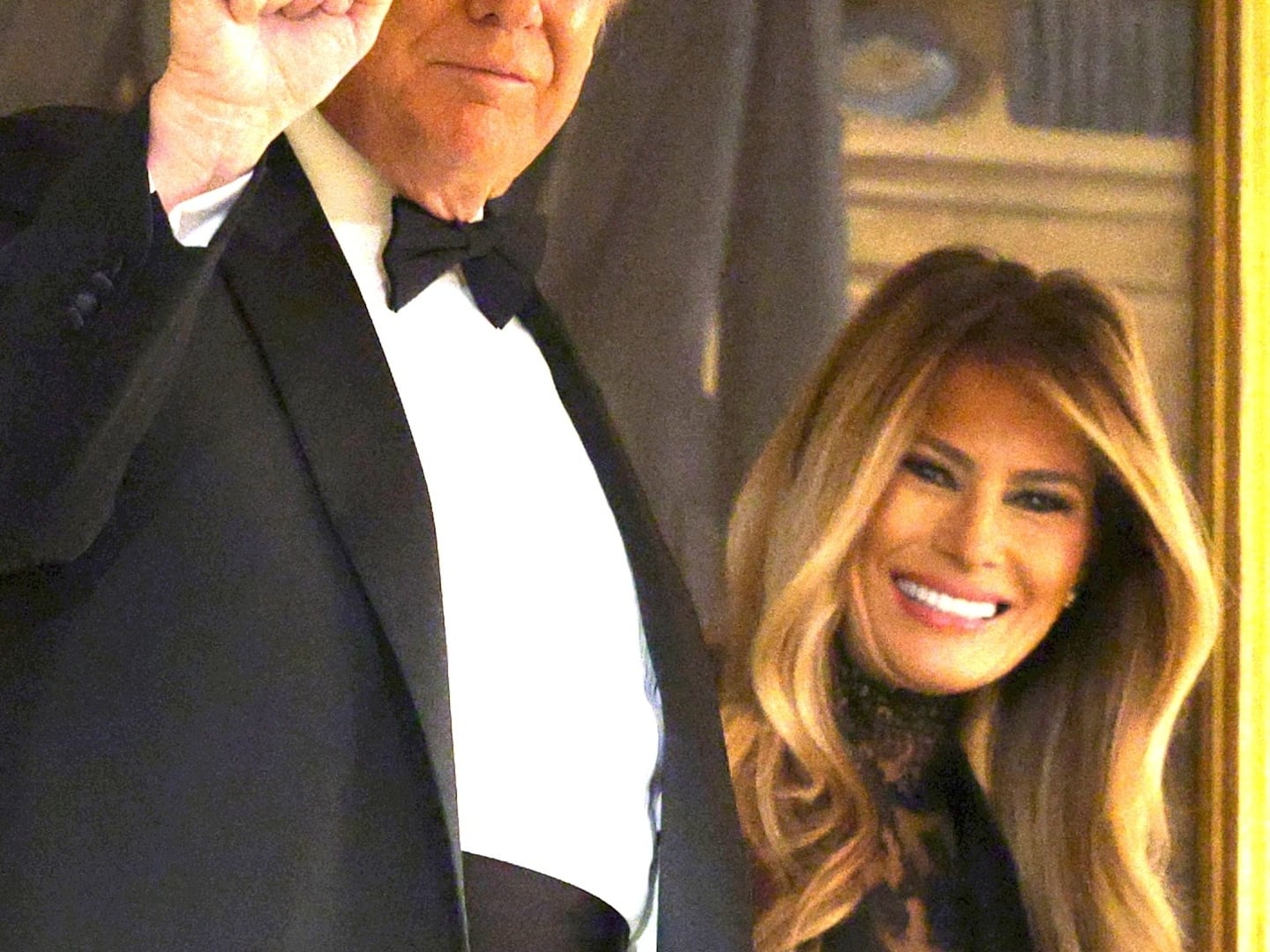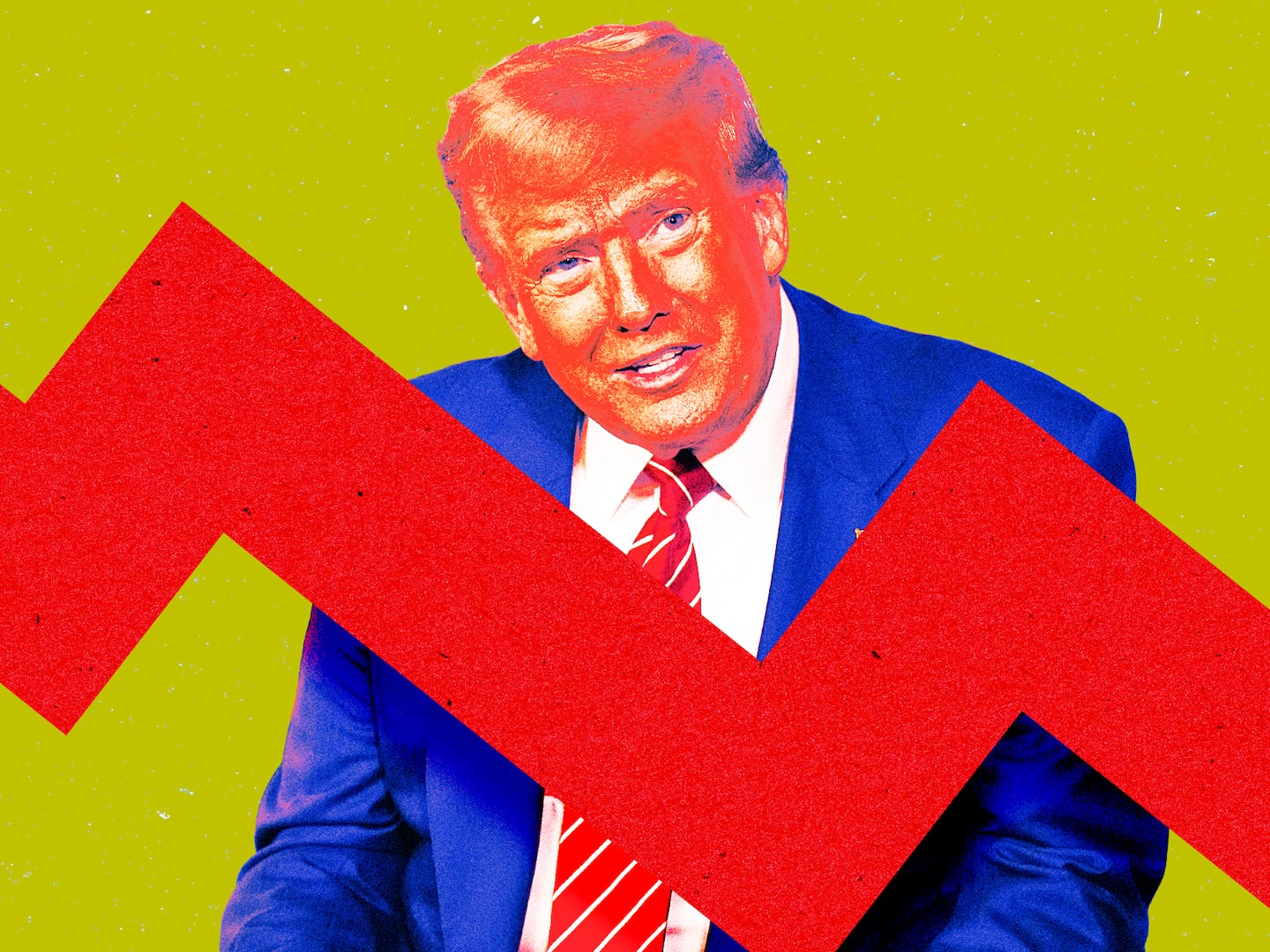As lifelong Star Wars worshippers, it took Dan Povenmire and Jeff “Swampy” Marsh, creators of the hit Disney Channel animated series Phineas and Ferb, mere seconds to spring into action in October 2012 after learning that Disney had acquired Lucasfilm, and rights to the Star Wars franchise. Povenmire immediately sketched a picture of Dr. Doofenshmirtz—their show’s iconic, and idiotic, evil scientist—as Darth Vader. Recalls Marsh, “Dan did this drawing within moments, photographed it and texted it to our head of production Eric [Coleman] with the note, ‘I smell crossover!’”
Two years later, Povenmire’s little doodle now represents Disney’s first foray into its newly-acquired Star Wars universe. And the Force is indeed strong with Phineas and Ferb: Star Wars. Premiering 9 p.m. ET/PT Saturday on the Disney Channel, the special is everything a Star Wars fan—and a Phineas and Ferb fan—could have hoped for: an hour show that pays loving homage to the film that generations have loved (including the judicious use of original Star Wars music and sound effects), while also merrily, and wittily, poking fun at it.
It’s the second Phineas and Ferb crossover with a major Disney-owned franchise: in last summer’s Mission Marvel, the Avengers visited Phineas and Ferb’s hometown of Danville. That special kept close to Phineas’s core: the series is about two relentlessly optimistic, self-assured and inventive stepbrothers who spend each day of their summer vacation constructing one extravagant new project after another, while older sister Candace keeps trying to “bust” them to their parents. Meanwhile, their pet platypus, Perry, goes on secret missions as Agent P, trying to thwart Doofenshmirtz’s latest ill-planned scheme to take over “the Tri-State Area.”
Phineas and Ferb: Star Wars, however, takes place wholly in the world of Star Wars (or, as the 1977 classic is now technically called, Star Wars: Episode IV—A New Hope). In true Rosencrantz and Guildenstern Are Dead/Back to the Future Part II fashion, the story unfolds in tandem with the events of Star Wars, with many of the film’s most iconic moments (like Luke and Leia swinging over the Death Star chasm) taking place in the background of Phineas and Ferb’s adventures. The boys are moisture farmers on Tatooine (and pals with Luke) who end up in possession of the Death Star plans Leia gave to R2-D2 after accidentally hitting the droid with their speeder (Candace, meanwhile, is a Stormtrooper.) They enlist the help of pal Isabella, captain of the Centennial Chihuahua spaceship, who is also a longtime rival of Han Solo. Doofenshmirtz, here called Darthenshmirtz, is of course, the “idiot” who designed the easy-to-destroy Death Star, and is being pursued by Perry the Rebelpus. Also, like many Phineas special episodes, the hour features several musical numbers. But as the opening crawl assures, “none of this is canon, so just relax.”
Since 1977, Star Wars has been an essential touchstone for both Povenmire and Marsh. “I was the very first kid in line for the very first showing of Star Wars in Mobile, Alabama. I saw it 19 times that summer,” says Povenmire. Marsh was also instantly enraptured. “That was the film that for so many of us who later went on to become storytellers of all various forms, that consumed that summer for us—and most of the next year after that,” Marsh says. “It changed the way we played. It changed the way we imagined. It changed the way we told stories forever. I think all of us who are impacted by it have been referencing it in one way or another for years in our work. We’ve been paying homage to it, and stealing scenes and bits from that.”
As they mulled how to best pull off the crossover, “we talked about the two ways we could do it,” says Povenmire. “We could do it like Family Guy did, with our characters as their characters.” But, explains Marsh, “we thought the other people that we’d seen do that had done it really well.” The other, more ambitious option was the Rosencrantz and Guildenstern Are Dead approach they ultimately went with. Quips Marsh, “We know how much kids like Tom Stoppard. That’s the one we want.” As Povenmire explains, “I felt like that’s going to be much more difficult, but I thought it would be much more rewarding if we did it right.”
Lucasfilm was receptive to the idea. “They laughed in all the right places,” says Povenmire. “We had already written the Doofenshmirtz song for the second act that ends with Doofenshmirtz saying, ‘Darth Vader can kiss my Bantha!’ I played that demo for them on my phone and they laughed out loud. It was a really easy pitch. They’re not the stoic executives that you might expect.”
It also helped that their success last summer with Mission Marvel made this a much easier sell for both Lucasfilm and Disney. “If you see the Marvel thing, that probably alleviates a lot of your fears right off the bat, because we didn’t go in and make fun of the Marvel characters,” says Marsh. “We worked really hard to make sure that the humor we got was derived from who those characters were.”
Since its debut in 2007, Phineas and Ferb has been the rare childrens show that—like SpongeBob SquarePants—is equally, and sometimes even more, entertaining to parents as it is to their kids. That’s because Povenmire and Marsh emulated the Chuck Jones formula of layering their shows with jokes that viewers will appreciate even more as they grow older. “When we watched them again in high school and college, you catch all these other levels of humor,” says Povenmire. “To me, that’s the best thing. The kids who are watching Phineas today will see it again with their kids someday, and they’ll get a whole other level of jokes that they didn’t get before.”
Adds Marsh, “We tell the guys, ‘You’re not writing kid jokes. Write funny jokes.’ You can never go wrong betting on the kids being smarter than everybody gives them credit for. Never. If we just did jokes that went over the kid’s heads, that would be a problem, but trust me, the next one we tell is going to be stupid. We’re going to follow it with a song called, ‘Squirrels in My Pants.’ You can guarantee that following the joke about existentialist trading cards will be a classic piece of slapstick.” Povenmire interjects, “Kids love jokes about Nietzsche. They eat that stuff up.”
It’s the same approach they applied to Phineas and Ferb: Star Wars, and in doing so, they managed to pull off a satirical take on the galaxy far, far away that feels fresh and completely different from other famous Star Wars spoofs in recent years, like those from Family Guy or Povenmire’s favorite, Robot Chicken. Their team was so eager to pile on as many Star Wars references as possible that at one point, they had three hours worth of storyboards for the hour-long program. As a result, the special is packed with in-jokes for fans, including a “who shot first?” line in Mos Eisley Cantina and the recurring depiction of Porkins—the film’s hefty X-Wing pilot—as the show’s punching bag. “He’s the only guy we didn’t go for any kind of sound-alike at all,” says Povenmire. “We got sound-alikes for minor characters, but for Porkins, it was like, let’s make him somewhere between Porkins and the comic book guy from The Simpsons.” There’s also a cameo from Povenmire and Marsh as the Death Star employees who operate the tractor beam. “They drew it to look like us and we did the voice, which was very fun,” says Povenmire, who also regularly voices Doofenshmirtz on the show (Marsh is the voice of Agent P’s boss, Major Monogram).
The Phineas and Ferb: Star Wars story is “perfectly accurate” with the New Hope action going on in the background, says Povenmire. “A lot of that stuff we rotoscoped to the actual footage. If it’s from the same angle just in the background, like the trash scene, that’s rotoscoped right off of the original footage. And like Luke and Leia swinging by in the background, our board artist counted how many shots hit the thing after they go across, and had them hit in the right place.”
Their strict adherence to the Star Wars story, and referencing the film’s most iconic moments, also led to another conundrum: Star Wars features many, many deaths—at one point, the planet of Alderaan, and everyone living on it, is obliterated—which is a no-no for Disney Channel programs. Povenmire and Marsh navigated that by skipping over doomed characters like Luke’s Uncle Owen and Aunt Beru (“although in the early stages, the writers had plenty of gag pitches,” says Marsh), and recasting other potentially traumatic moments, like Alderaan’s destruction, as jokes. Darthenshmirtz is shown checking on the property value of his Alderaan timeshare, which plummets as the planet explodes in the background. “We blew up an entire planet, just for a Doofenshmirtz gag,” laughs Povenmire.
At the special’s conclusion, one character talks about living on to fight in the sequel. Does that mean will there be one? Disney hasn’t committed to anything yet, but Povenmire and Marsh are eager to make more. “We announced we were doing Phineas and Ferb: Star Wars at Comic-Con last year and it got such a huge response,” recalls Povenmire. “I mean, the room shook. And I talked to the head of the studio afterwards and he was like, ‘That was cool!’ And I was like, ‘Does that mean we get to do Empire and Jedi?’ And he says, ‘I don’t know. We’ll have to see.’ I didn’t even realize we had that much of a crossover. Because a lot of times I think kids today may not have ever even seen Star Wars—and a lot of them haven’t.”
In the year since that Comic-Con announcement, the Star Wars fan frenzy has only increased now that Episode VII has begun filming, and several other future Star Wars films from the Expanded Universe have been announced. With Star Wars Rebels, a new animated series for Disney Channel and Disney XD, not premiering until this fall, Phineas and Ferb: Star Wars offers audiences their first glimpse at what the franchise will look like going forward with Disney at the helm. “There are a lot of diehard fans who I think are genuinely worried about Disney doing Star Wars,” admits Marsh. “We were aware of it going into it but we thought, ‘We’re those guys.’ I don’t think there’s anybody better to have done this than a bunch of those guys who have exactly those same concerns and just wanted to make sure we did something that everybody on the crew, everybody at Lucasfilm and everybody at Disney would be proud of.”
After pulling off Marvel and now Star Wars crossovers successfully, what will they do next? There’s one still-untouched franchise in Disney’s arsenal that seems perfect for Phineas and Ferb: the Indiana Jones films. “From your mouth to Disney’s ears, we would love to do Indiana Jones,” says Povenmire. But Disney isn’t entrusting them with any additional properties until it sees how their take on Star Wars is received. “Part of the reason this happened is because they’re making Episode VII and they’re making new Marvel episodes,” says Povenmire. “If they start talking soon about making another Indiana Jones, then we may get the call. But they’re thinking, ‘If we do this, we get a whole new group of kids who may have never seen Star Wars interested in it through Phineas and Ferb,’ and it’s a win-win for them.”
While more Star Wars specials seem like a strong possibility—and Povenmire and Mash are also contracted for three additional hour-long Phineas and Ferb specials —the future of Phineas and Ferb as a series is much more in doubt. They are still working in post-production on approximately 20 Season 4 episodes that have yet to air, but beyond that, “we don’t have anything scheduled,” says Marsh, noting that “Phineas and Ferb have had 250 days of summer vacation,” more than double the 104 days mentioned in the show’s theme song. Adds Povenmire, “What we have is the first hiatus, because we’ve been going at a breakneck pace for eight years. Most TV, you finish, you let it air and then you see what the next one is going to be, and we’re finally in that mode.”
For now, they’re focusing all their efforts on Phineas and Ferb: Star Wars, which they hope will be as warmly embraced by the fan community as other comedic takes on the franchise have been throughout the years.
“I remember one of the first science-fiction conventions that I went to in Biloxi, Miss., there were a bunch of college kids sitting around, and one of them had memorized all the lyrics to the Mad Magazine song that C-3PO or Luke sings,” says Povenmire. “She was singing it at this party and everybody was just loving it. And I thought, ‘I think our songs will get sung at science-fiction conventions!’ I think that’ll be a badge of honor a few years from now if you know all the words to ‘Tatooine.’ That’s what I’m hoping. That would be really cool.”






